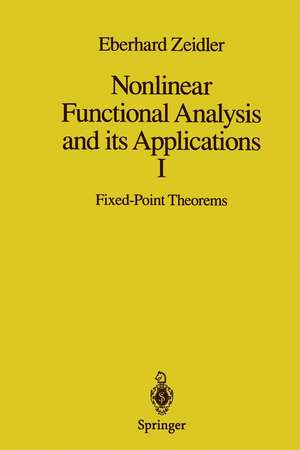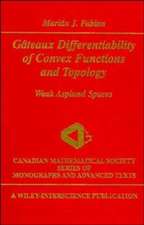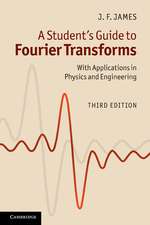Nonlinear Functional Analysis and its Applications: I: Fixed-Point Theorems
Traducere de P.R. Wadsack Autor Eberhard Zeidleren Limba Engleză Hardback – 6 noi 1998
| Toate formatele și edițiile | Preț | Express |
|---|---|---|
| Paperback (1) | 1573.69 lei 43-57 zile | |
| Springer – 14 oct 2011 | 1573.69 lei 43-57 zile | |
| Hardback (1) | 1583.36 lei 43-57 zile | |
| Springer – 6 noi 1998 | 1583.36 lei 43-57 zile |
Preț: 1583.36 lei
Preț vechi: 1930.92 lei
-18% Nou
Puncte Express: 2375
Preț estimativ în valută:
303.07€ • 329.31$ • 254.74£
303.07€ • 329.31$ • 254.74£
Carte tipărită la comandă
Livrare economică 21 aprilie-05 mai
Preluare comenzi: 021 569.72.76
Specificații
ISBN-13: 9780387909141
ISBN-10: 0387909141
Pagini: 909
Ilustrații: XXIII, 909 p. 1 illus.
Dimensiuni: 155 x 235 x 51 mm
Greutate: 1.56 kg
Ediția:1st ed. 1986. Corr. 3rd printing 1998
Editura: Springer
Colecția Springer
Locul publicării:New York, NY, United States
ISBN-10: 0387909141
Pagini: 909
Ilustrații: XXIII, 909 p. 1 illus.
Dimensiuni: 155 x 235 x 51 mm
Greutate: 1.56 kg
Ediția:1st ed. 1986. Corr. 3rd printing 1998
Editura: Springer
Colecția Springer
Locul publicării:New York, NY, United States
Public țintă
ResearchDescriere
The greatest mathematicians, such as Archimedes, Newton, and Gauss, always united theory and applications in equal measure. Felix Klein There exists the remarkable possibility that one can master a subject mathemati cally, without really understanding its essence. Albert Einstein Don't give us numbers: give us insight! A contemporary natural scientist to a mathematician Numerous questions in physics, chemistry, biology, and economics lead to nonlinear problems; for example, deformation of rods, plates, and shells; behavior of plastic materials; surface waves of fluids; flows around objects in fluids or gases; shock waves in gases; movement of viscous fluids; equilibrium forms of rotating fluids in astrophysics; determination of the shape of the earth through gravitational measu- ments; behavior of magnetic fields of astrophysical objects; melting processes; chemical reactions; heat radiation; processes in nuclear reactors; nonlinear oscillation in physics, chemistry, and biology; 2 Introduction existence and stability of periodic and quasiperiodic orbits in celestial mechanics; stability of physical, chemical, biological, ecological, and economic processes; diffusion processes in physics, chemistry, and biology; processes with entropy production, and self-organization of systems in physics, chemistry, and biology; study of the electrical potential variation in the heart through measure ments on the body surface to prevent heart attacks; determining material constants or material laws (e. g.
Cuprins
Fundamental Fixed-Point Principles.- 1 The Banach Fixed-Point Theorem and Iterative Methods.- §1.1. The Banach Fixed-Point Theorem.- §1.2. Continuous Dependence on a Parameter.- §1.3. The Significance of the Banach Fixed-Point Theorem.- §1.4. Applications to Nonlinear Equations.- §1.5. Accelerated Convergence and Newton’s Method.- § 1.6. The Picard-Lindelof Theorem.- §1.7. The Main Theorem for Iterative Methods for Linear Operator Equations.- §1.8. Applications to Systems of Linear Equations.- §1.9. Applications to Linear Integral Equations.- 2 The Schauder Fixed-Point Theorem and Compactness.- §2.1. Extension Theorem.- §2.2. Retracts.- §2.3. The Brouwer Fixed-Point Theorem.- §2.4. Existence Principle for Systems of Equations.- §2.5. Compact Operators.- §2.6. The Schauder Fixed-Point Theorem.- §2.7. Peano’s Theorem.- §2.8. Integral Equations with Small Parameters.- §2.9. Systems of Integral Equations and Semilinear Differential Equations.- §2.10. A General Strategy.- §2.11. Existence Principle for Systems of Inequalities.- Applications of the Fundamental Fixed-Point Principles.- 3 Ordinary Differential Equations in B-spaces.- §3.1. Integration of Vector Functions of One Real Variable t.- §3.2. Differentiation of Vector Functions of One Real Variable t.- §3.3. Generalized Picard-Lindelöf Theorem.- §3.4. Generalized Peano Theorem.- §3.5. Gronwall’s Lemma.- §3.6. Stability of Solutions and Existence of Periodic Solutions.- §3.7. Stability Theory and Plane Vector Fields, Electrical Circuits, Limit Cycles.- §3.8. Perspectives.- 4 Differential Calculus and the Implicit Function Theorem.- §4.1. Formal Differential Calculus.- §4.2. The Derivatives of Fréchet and Gâteaux.- §4.3. Sum Rule, Chain Rule, and Product Rule.- §4.4. Partial Derivatives.- §4.5. Higher Differentials and Higher Derivatives.- §4.6. Generalized Taylor’s Theorem.- §4.7. The Implicit Function Theorem.- §4.8. Applications of the Implicit Function Theorem.- §4.9. Attracting and Repelling Fixed Points and Stability.- §4.10. Applications to Biological Equilibria.- §4.11. The Continuously Differentiable Dependence of the Solutions of Ordinary Differential Equations in B-spaces on the Initial Values and on the Parameters.- §4.12. The Generalized Frobenius Theorem and Total Differential Equations.- §4.13. Diffeomorphisms and the Local Inverse Mapping Theorem.- §4.14. Proper Maps and the Global Inverse Mapping Theorem.- §4.15. The Suijective Implicit Function Theorem.- §4.16. Nonlinear Systems of Equations, Subimmersions, and the Rank Theorem.- §4.17. A Look at Manifolds.- §4.18. Submersions and a Look at the Sard-Smale Theorem.- §4.19. The Parametrized Sard Theorem and Constructive Fixed-Point Theory.- 5 Newton’s Method.- §5.1. A Theorem on Local Convergence.- §5.2. The Kantorovi? Semi-Local Convergence Theorem.- 6 Continuation with Respect to a Parameter.- §6.1. The Continuation Method for Linear Operators.- §6.2. B-spaces of Hölder Continuous Functions.- §6.3. Applications to Linear Partial Differential Equations.- §6.4. Functional-Analytic Interpretation of the Existence Theorem and its Generalizations.- §6.5. Applications to Semi-linear Differential Equations.- §6.6. The Implicit Function Theorem and the Continuation Method.- §6.7. Ordinary Differential Equations in B-spaces and the Continuation Method.- §6.8. The Leray—Schauder Principle.- §6.9. Applications to Quasi-linear Elliptic Differential Equations.- 7 Positive Operators.- §7.1. Ordered B-spaces.- §7.2. Monotone Increasing Operators.- §7.3. The Abstract Gronwall Lemma and its Applications to Integral Inequalities.- §7.4. Supersolutions, Subsolutions, Iterative Methods, and Stability.- §7.5. Applications.- §7.6. Minorant Methods and Positive Eigensolutions.- §7.7. Applications.- §7.8. The Krein-Rutman Theorem and its Applications.- §7.9. Asymptotic Linear Operators.- §7.10. Main Theorem for Operators of Monotone Type.- §7.11. Application to a Heat Conduction Problem.- §7.12. Existence of Three Solutions.- §7.13. Main Theorem for Abstract Hammerstein Equations in Ordered B-spaces.- §7.14. Eigensolutions of Abstract Hammerstein Equations, Bifurcation, Stability, and the Nonlinear Krein-Rutman Theorem.- §7.15. Applications to Hammerstein Integral Equations.- §7.16. Applications to Semi-linear Elliptic Boundary-Value Problems.- §7.17. Application to Elliptic Equations with Nonlinear Boundary Conditions.- §7.18. Applications to Boundary Initial-Value Problems for Parabolic Differential Equations and Stability.- 8 Analytic Bifurcation Theory.- §8.1. A Necessary Condition for Existence of a Bifurcation Point.- §8.2. Analytic Operators.- §8.3. An Analytic Majorant Method.- §8.4. Fredholm Operators.- §8.5. The Spectrum of Compact Linear Operators (Riesz—Schauder Theory).- §8.6. The Branching Equations of Ljapunov—Schmidt.- §8.7. The Main Theorem on the Generic Bifurcation From Simple Zeros.- §8.8. Applications to Eigenvalue Problems.- §8.9. Applications to Integral Equations.- §8.10. Application to Differential Equations.- §8.11. The Main Theorem on Generic Bifurcation for Multiparametric Operator Equations—The Bunch Theorem.- §8.12. Main Theorem for Regular Semi-linear Equations.- §8.13. Parameter-Induced Oscillation.- §8.14. Self-Induced Oscillations and Limit Cycles.- §8.15. Hopf Bifurcation.- §8.16. The Main Theorem on Generic Bifurcation from Multiple Zeros.- §8.17. Stability of Bifurcation Solutions.- §8.18. Generic Point Bifurcation.- 9 Fixed Points of Multivalued Maps.- §9.1. Generalized Banach Fixed-Point Theorem.- §9.2. Upper and Lower Semi-continuity of Multivalued Maps.- §9.3. Generalized Schauder Fixed-Point Theorem.- §9.4. Variational Inequalities and the Browder Fixed-Point Theorem.- §9.5. An Extremal Principle.- §9.6. The Minimax Theorem and Saddle Points.- §9.7. Applications in Game Theory.- §9.8. Selections and the Marriage Theorem.- §9.9. Michael’s Selection Theorem.- §9.10. Application to the Generalized Peano Theorem for Differential Inclusions.- 10 Nonexpansive Operators and Iterative Methods.- §10.1. Uniformly Convex B-spaces.- §10.2. Demiclosed Operators.- §10.3. The Fixed-Point Theorem of Browder, Göhde, and Kirk.- §10.4. Demicompact Operators.- §10.5. Convergence Principles in B-spaces.- §10.6. Modified Successive Approximations.- §10.7. Application to Periodic Solutions.- 11 Condensing Maps and the Bourbaki—Kneser Fixed-Point Theorem.- §11.1. A Noncompactness Measure.- §11.2. Applications to Generalized Interval Nesting.- §11.3. Condensing Maps.- §11.4. Operators with Closed Range and an Approximation Technique for Constructing Fixed Points.- §11.5. Sadovskii’s Fixed-Point Theorem for Condensing Maps.- §11.6. Fixed-Point Theorems for Perturbed Operators.- §11.7. Application to Differential Equations in B-spaces.- §11.8. The Bourbaki-Kneser Fixed-Point Theorem.- § 11.9. The Fixed-Point Theorems of Amann and Tarski.- §11.10. Application to Interval Arithmetic.- §11.11. Application to Formal Languages.- The Mapping Degree and the Fixed-Point Index.- 12 The Leray-Schauder Fixed-Point Index.- §12.1. Intuitive Background and Basic Concepts.- §12.2. Homotopy.- §12.3. The System of Axioms.- §12.4. An Approximation Theorem.- §12.5. Existence and Uniqueness of the Fixed-Point Index in ?N.- §12.6. Proof of Theorem 12.A..- §12.7. Existence and Uniqueness of the Fixed-Point Index in B-spaces.- §12.8. Product Theorem and Reduction Theorem.- 13 Applications of the Fixed-Point Index.- §13.1. A General Fixed-Point Principle.- §13.2. A General Eigenvalue Principle.- §13.3. Existence of Multiple Solutions.- §13.4. A Continuum of Fixed Points.- §13.5. Applications to Differential Equations.- §13.6. Properties of the Mapping Degree.- §13.7. The Leray Product Theorem and Homeomorphisms.- §13.8. The Jordan-Brouwer Separation Theorem and Brouwer’s Invariance of Dimension Theorem.- §13.9. A Brief Glance at the History of Mathematics.- §13.10. Topology and Intuition.- §13.11. Generalization of the Mapping Degree.- 14 The Fixed-Point Index of Differentiable and Analytic Maps.- §14.1. The Fixed-Point Index of Classical Analytic Functions.- §14.2. The Leray—Schauder Index Theorem.- §14.3. The Fixed-Point Index of Analytic Mappings on Complex B-spaces.- §14.4. The Schauder Fixed-Point Theorem with Uniqueness.- §14.5. Solution of Analytic Operator Equations.- §14.6. The Global Continuation Principle of Leray—Schauder.- §14.7. Unbounded Solution Components.- §14.8. Applications to Systems of Equations.- §14.9. Applications to Integral Equations.- §14.10. Applications to Boundary-Value Problems.- §14.11. Applications to Integral Power Series.- 15 Topological Bifurcation Theory.- §15.1. The Index Jump Principle.- §15.2. Applications to Systems of Equations.- §15.3. Duality Between the Index Jump Principle and the Leray—Schauder Continuation Principle.- §15.4. The Geometric Heart of the Continuation Method.- §15.5. Stability Change and Bifurcation.- §15.6. Local Bifurcation.- §15.7. Global Bifurcation.- §15.8. Application to Systems of Equations.- §15.9. Application to Integral Equations.- §15.10. Application to Differential Equations.- §15.11. Application to Bifurcation at Infinity.- §15.12. Proof of the Main Theorem.- §15.13. Preventing Secondary Bifurcation.- 16 Essential Mappings and the Borsuk Antipodal Theorem.- §16.1. Intuitive Introduction.- §16.2. Essential Mappings and their Homotopy Invariance.- §16.3. The Antipodal Theorem.- §16.4. The Invariance of Domain Theorem and Global Homeomorphisms.- §16.5. The Borsuk—Ulam Theorem and its Applications.- §16.6. The Mapping Degree and Essential Maps.- §16.7. The Hopf Theorem.- §16.8. A Glance at Homotopy Theory.- 17 Asymptotic Fixed-Point Theorems.- §17.1. The Generalized Banach Fixed-Point Theorem.- §17.2. The Fixed-Point Index of Iterated Mappings.- §17.3. The Generalized Schauder Fixed-Point Theorem.- §17.4. Application to Dissipati ve Dynamical Systems.- §17.5. Perspectives.- References.- Additional References to the Second Printing.- List of Symbols.- List of Theorems.- List of the Most Important Definitions.- Schematic Overviews.- General References to the Literature.- List of Important Principles.- of the Other Parts.

















